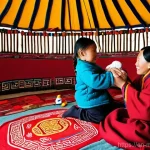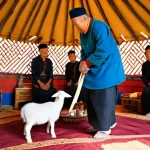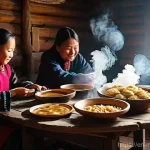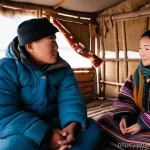Imagine sitting around a crackling fire under a vast, star-studded Mongolian sky. For centuries, the stories of brave heroes, mythical creatures, and epic journeys have been passed down through generations via oral tradition.
These aren’t just stories; they are the heart and soul of Mongolian culture, encapsulating their history, values, and worldview. It’s like a living history book, filled with adventure, romance, and timeless wisdom.
Think of it as Mongolia’s version of the Odyssey or the Iliad, but with a unique nomadic twist. I’ve always been fascinated by how these narratives shaped the culture and continue to resonate today.
So, let’s delve into the fascinating world of Mongolian epic poetry and uncover its hidden treasures. Let’s explore this further in the article below!
Alright, let’s dive deeper into Mongolian epic poetry!
Unveiling the Rich Tapestry of Mongolian Oral Tradition
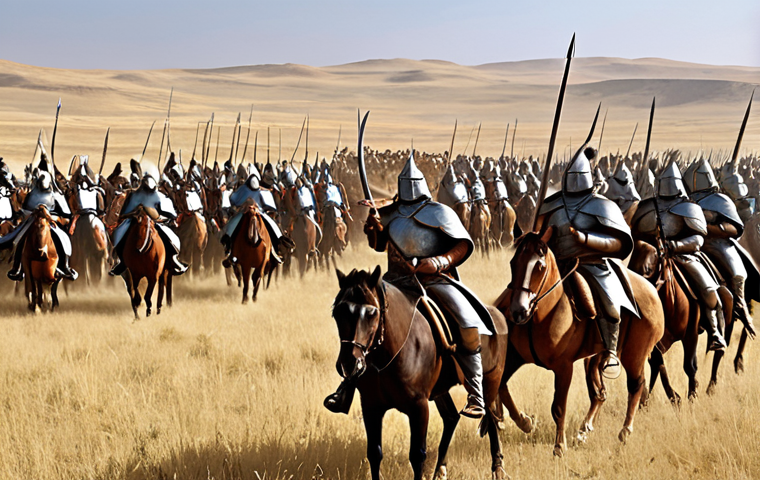
1. Echoes of Nomadic Life in Epic Tales
Imagine vast steppes, galloping horses, and the close-knit communities of nomadic tribes. These are the backdrops against which Mongolian epic poetry thrives. These stories, passed down through generations, are filled with vivid imagery of the nomadic lifestyle. I remember reading about one epic where the hero’s connection to his horse was so profound, it felt like they were one entity. The epic details the hero’s journey across the endless plains, battling mythical creatures and overcoming incredible odds. The tales vividly portray the deep connection to nature, the importance of livestock, and the constant movement that defined their existence. It’s not just about adventure; it’s about survival, resilience, and the unbreakable bonds of family and community. I once spoke with a Mongolian elder who recounted how these epics taught him the values of courage, loyalty, and respect for the land. He said, “These stories are our inheritance; they guide us through life.” And truly, you can feel that ancient wisdom in every verse.
2. The Significance of Heroic Figures and Their Quests
Mongolian epics are brimming with larger-than-life heroes who embark on epic quests, often involving battles against monstrous foes and the pursuit of great treasures. These heroes aren’t just strong warriors; they embody the virtues that Mongolian society holds dear – bravery, loyalty, wisdom, and compassion. I remember being particularly struck by the story of a hero who chose to sacrifice his own life to save his people from a terrible drought. His selflessness and unwavering commitment to the greater good were truly inspiring. These heroic figures serve as role models, teaching valuable lessons about morality, justice, and the importance of standing up for what is right. Their quests often take them to far-off lands, where they encounter mythical creatures, solve ancient riddles, and forge alliances with other tribes. It’s a world of constant adventure and challenge, where only the most courageous and resourceful can prevail. Each challenge tests the hero’s character and resolve, ultimately shaping them into the leader their people need.
The Enduring Themes and Moral Lessons Within the Epics
1. Justice, Loyalty, and the Triumph of Good
At the heart of Mongolian epic poetry lie enduring themes of justice, loyalty, and the ultimate triumph of good over evil. These epics often feature conflicts between righteous heroes and villainous antagonists, where the fate of entire communities hangs in the balance. I was particularly moved by an epic where the hero remained steadfastly loyal to his clan, even when faced with betrayal and temptation. His unwavering commitment to his people was a powerful reminder of the importance of integrity and faithfulness. The epics teach us that while the path to justice may be arduous and fraught with obstacles, perseverance and moral strength will ultimately prevail. They reinforce the idea that good deeds are rewarded, and evil actions are punished, providing a moral compass for listeners and readers. These themes resonate even today, reminding us of the importance of upholding ethical principles and fighting for what is right.
2. The Interconnectedness of Humans and Nature
Mongolian epic poetry reflects a deep respect for nature and highlights the interconnectedness of humans and the environment. The natural world is often portrayed as a powerful force, capable of both providing sustenance and unleashing devastating storms. Heroes in these epics possess a profound understanding of the natural world, using their knowledge of weather patterns, animal behavior, and medicinal plants to overcome challenges. I remember reading about a hero who could communicate with animals, learning valuable information about upcoming dangers and finding hidden resources. This intimate connection with nature is not just a practical skill; it’s a spiritual bond. The epics teach us that we are all part of a larger ecosystem and that our actions have consequences. They encourage us to live in harmony with nature, respecting its power and appreciating its beauty. The land itself is a character, often influencing the hero’s journey and shaping their destiny.
The Art of Storytelling: Performance and Preservation
1. Bards and the Tradition of Oral Transmission
Mongolian epic poetry is not just about the words on a page; it’s a living tradition that is brought to life through the performances of skilled bards. These bards, often travelling from village to village, possess an incredible ability to memorize vast amounts of text and deliver them with captivating energy and emotion. I once had the opportunity to witness a performance by a renowned Mongolian bard, and it was an unforgettable experience. The bard sang for hours, his voice rising and falling with the rhythm of the story, his gestures bringing the characters to life. The audience was completely enthralled, hanging on every word. The art of oral transmission is crucial for preserving these epics, ensuring that they are passed down to future generations. Bards are not just performers; they are guardians of cultural heritage. They undergo rigorous training, learning not only the words of the epics but also the history, customs, and values that they embody. They are the living embodiment of Mongolian epic poetry.
2. Musical Accompaniment and Ritualistic Elements
The performance of Mongolian epic poetry is often accompanied by music, typically played on traditional instruments like the Morin Khuur (horsehead fiddle) or the Tovshuur (lute). The music adds another layer of depth to the storytelling, enhancing the emotional impact and creating a truly immersive experience. I’ve always found the haunting melodies of the Morin Khuur to be particularly evocative, perfectly capturing the vastness and beauty of the Mongolian landscape. In some cases, the performance of epics is also intertwined with ritualistic elements, such as prayers, offerings, and dances. These rituals are intended to honor the spirits of ancestors, invoke blessings for the community, and ensure the successful transmission of the epic. The combination of music, storytelling, and ritual creates a powerful and transformative experience for both the performer and the audience.
Notable Mongolian Epics and Their Significance
1. “The Epic of Gesar”: A Tale of Divine Heroism
“The Epic of Gesar” stands as one of the most renowned and widely celebrated epic cycles in Mongolia. It tells the story of Gesar, a divine hero who descends from the heavens to rid the world of evil and establish peace and prosperity. This epic is not merely an adventure story; it is a complex and multifaceted narrative that explores themes of morality, leadership, and the struggle between good and evil. I found the portrayal of Gesar’s character particularly compelling. He is not just a powerful warrior; he is also a compassionate leader who cares deeply for his people. The epic is filled with epic battles, magical encounters, and profound philosophical insights. It has been passed down through generations, evolving and adapting to reflect the changing social and political landscape of Mongolia. The Epic of Gesar encapsulates the ideals of heroism, justice, and spiritual enlightenment, serving as a source of inspiration and guidance for countless generations.
2. “Jangar”: A Saga of Legendary Warriors and Their Homeland
“Jangar” is another prominent epic cycle that narrates the heroic exploits of the legendary warriors of the Bum Erdeni country. It is known for its vivid descriptions of the land, the battles, and the characters, presenting a vibrant portrayal of Mongolian culture and values. I was particularly impressed by the intricate details used to describe the weapons, clothing, and customs of the Bum Erdeni warriors, providing a rich and immersive cultural experience. The epic explores themes of loyalty, courage, and the importance of defending one’s homeland. The battles are described with incredible detail, showcasing the strategic brilliance and martial prowess of the warriors. “Jangar” is more than just a war story; it is a celebration of Mongolian identity, resilience, and the enduring spirit of the people.
Modern Adaptations and the Future of Mongolian Epic Poetry
1. Preserving Tradition in a Changing World
In an increasingly globalized world, preserving the tradition of Mongolian epic poetry is more important than ever. Efforts are being made to document, record, and promote these epics to ensure that they continue to be passed down to future generations. I recently learned about a project that is working to create digital archives of Mongolian epics, making them accessible to a wider audience. This is a crucial step in safeguarding this invaluable cultural heritage. Furthermore, there is a growing interest in incorporating elements of Mongolian epic poetry into modern art forms, such as music, theatre, and film. This allows these ancient stories to reach new audiences and resonate with contemporary audiences. By finding innovative ways to preserve and promote Mongolian epic poetry, we can ensure that it continues to inspire and enrich the lives of people around the world.
2. The Role of Education and Cultural Exchange
Education plays a vital role in ensuring the survival of Mongolian epic poetry. By introducing these epics to children in schools, we can foster a sense of pride in their cultural heritage and encourage them to become active participants in its preservation. I was particularly heartened to hear about a program that brings traditional bards into schools to perform for students and teach them about the art of storytelling. Cultural exchange also plays a crucial role. By sharing Mongolian epic poetry with people from other cultures, we can promote understanding and appreciation for this unique and valuable tradition. International festivals, academic conferences, and cultural exhibitions can all serve as platforms for showcasing the richness and diversity of Mongolian epic poetry. By embracing both education and cultural exchange, we can ensure that these timeless stories continue to resonate with audiences around the world.
The Geographical and Cultural Influence on the Epics
1. The Steppe as a Character
The vast, open steppe is more than just a backdrop; it’s a living, breathing character in Mongolian epics. The landscape shapes the narrative, influencing the hero’s journey and the challenges they face. Think of the unforgiving climate, the endless horizons, and the reliance on natural resources—all these elements permeate the stories. I’ve read epics where the hero’s knowledge of the steppe’s hidden springs and treacherous terrain is crucial to their survival. The environment isn’t just a setting; it’s an active participant in the story, testing the hero’s resilience and resourcefulness. It’s a reminder of the deep connection Mongolians have with their land, a relationship built on respect and necessity. Each mountain, river, and valley has a story to tell, weaving itself into the fabric of the epics.
2. Cultural Values Embodied in the Narrative
Mongolian epics are rich with cultural values such as respect for elders, loyalty to family, and the importance of community. These values aren’t just mentioned; they’re woven into the actions and decisions of the characters. I recall an epic where a hero faces a moral dilemma, choosing between personal glory and the well-being of his tribe. His ultimate decision reflects the deep-seated value of collective welfare over individual ambition. The narratives serve as moral guides, reinforcing the principles that hold Mongolian society together. These epics aren’t just entertainment; they’re cultural textbooks, teaching the younger generation about their heritage and the virtues they should aspire to. The stories connect them to their ancestors and provide a framework for navigating the complexities of life.
| Epic Title | Main Theme | Key Characters | Cultural Significance |
|---|---|---|---|
| The Epic of Gesar | Divine Heroism, Triumph of Good | Gesar, various demons and deities | Embodies ideals of heroism, justice, and spiritual enlightenment |
| Jangar | Legendary Warriors, Homeland Defense | Jangar, Bum Erdeni warriors | Celebrates Mongolian identity, resilience, and the spirit of the people |
| Other various tales | wisdom, bravery, and more | various heros and their people | Teaches moral values |
In Conclusion
Exploring Mongolian epic poetry offers a fascinating glimpse into the heart and soul of a culture shaped by nomadic life and profound values. These epics, passed down through generations, are not just stories; they are a living testament to the resilience, wisdom, and spirit of the Mongolian people. As we preserve and celebrate this rich tradition, we ensure that its timeless lessons continue to inspire and guide us.
Useful Information to Know
1. Morin Khuur Music Festivals: Attend local festivals featuring Morin Khuur performances to experience the musical accompaniment of epic poetry firsthand.
2. Mongolian Cultural Centers: Visit Mongolian cultural centers or museums in your area to learn more about the history and traditions of epic storytelling.
3. Books on Mongolian Folklore: Explore books on Mongolian folklore and mythology for in-depth analyses of epic themes and characters.
4. Documentary Films: Watch documentary films about Mongolian culture and traditions to gain a visual understanding of the epic’s historical context.
5. Online Resources: Utilize online resources such as academic journals, cultural websites, and digital archives to access a wealth of information about Mongolian epic poetry.
Key Points to Remember
Mongolian epic poetry vividly reflects nomadic life, featuring heroic figures on quests embodying bravery and loyalty. Themes of justice, loyalty, and the interconnectedness of humans and nature are central, emphasizing the triumph of good. The art of storytelling is preserved through bards, with musical accompaniment enhancing performances. Notable epics like “The Epic of Gesar” and “Jangar” showcase cultural values and historical significance. Modern adaptations and educational initiatives ensure the tradition continues in a changing world.
Frequently Asked Questions (FAQ) 📖
Q: What makes Mongolian epic poetry so unique and culturally significant?
A: Well, from my experience diving into these narratives, what truly sets Mongolian epic poetry apart is how deeply intertwined it is with the nomadic lifestyle and worldview.
It’s not just about telling tales of heroes; it’s about preserving their history, values, and connection to the land. Think of it like sitting around a campfire, listening to stories passed down through generations, each one adding a layer to the cultural tapestry.
The use of oral tradition is a huge deal too, because it allows the poems to evolve organically with the community. I felt a real sense of connection to the past while exploring these stories.
It’s like discovering a time capsule that keeps the spirit of Mongolia alive.
Q: Can you give me an example of a common theme or motif found in Mongolian epic poetry?
A: Absolutely! One recurring theme that I’ve noticed is the profound respect for nature and the environment. Seriously, it’s everywhere!
The epics often portray heroes who have a deep connection with the land, animals, and weather. Think about it: life on the steppe is tough, and survival depends on understanding and respecting the natural world.
I remember reading one particular epic where the hero’s strength was directly tied to his understanding of the changing seasons and the migratory patterns of animals.
In these narratives, nature isn’t just a backdrop; it’s a powerful force that shapes the characters and their destinies. It’s kind of like how we in the Western US revere the mountains and deserts; that respect is woven into our own narratives.
Q: Where can I find reliable resources or translations to learn more about Mongolian epic poetry?
A: That’s a great question! When I started exploring this topic, I found that one of the best resources is actually seeking out scholars who specialize in Mongolian studies or folklore.
Many universities with strong Asian studies programs have professors who are experts in this field. Also, check out academic journals and publications related to folklore and oral traditions.
You can also sometimes find translated versions of these epics, though translations can sometimes lose some of the original nuance. I’d recommend searching university press websites or cultural organizations dedicated to preserving Mongolian heritage.
I found it helpful to reach out to a local university library – they often have access to resources you can’t find easily online.
📚 References
Wikipedia Encyclopedia
구글 검색 결과
구글 검색 결과
구글 검색 결과
구글 검색 결과
구글 검색 결과


